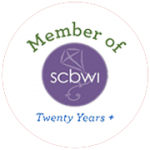 Today is Picture Book Wednesday and we’ll be talking about repetition, using the delightful Peepsqueak Wants a Friend! by Leslie Ann Clark.
Today is Picture Book Wednesday and we’ll be talking about repetition, using the delightful Peepsqueak Wants a Friend! by Leslie Ann Clark.
Repetition is a popular device in picture books. It enables the young listener to have the fun of anticipating something as well as providing an inherent rhythm to the text.
When I choose to repeat words, phrases or sentences in my stories, I’m usually asking myself why – why this word or phrase and not another one?
Here are some guidelines I use in answering that question.
Does my character perform a particularly fun or endearing action? If so, this may be an ideal choice for repetition. In Peepsqueak Wants a Friend!, Peepsqueak at first “hopped and skipped and ran” when he was leaving the barnyard. Then, as he searched for a friend, he “hopped, skipped, jumped, and skittered down the path.” This series of actions occurs six times, providing bouncy, active, fun words to read aloud and carry us through the story. The last one takes him off the path and into a cave…providing a shift and some light, shivery anticipation.
Does sound play a role in my story? If you’ve got some fun sound effects that would enhance the story by repeating them, go for it.
Is there a reversal or other type of switch with a word/phrase/sentence toward the end of the story? If so, this can suggest repetition so readers assume one thing–“down the path”–and then are surprised when it’s something else–“into a cold, dark cave.”
One caveat – don’t just repeat something for the sake of repeating it. That can laden your story with unnecessary text. Make sure the repetition feels right for your story.
There are many other ways that repetition may enhance a story. As you read as a writer, observe how repetition is used and to what effect. Share your observations here!




I know kids love the repetition, especially beginning readers. They love knowing what the words are going be even sometimes to the point of not looking at the words because they have memorized the pattern. So I wonder about the endings that break the pattern for those beginning readers. Is it good because it’s making them pay attention to the print? Is a surprise ending good for developing their sense of story? Is it not so good because if interrupts their flow as a reader and makes if hard to finish reading?
That’s a really good question and one I’ve never heard before! I’m trying to think of some book examples that break the pattern – do you have examples? I’d love to ask this of an editor of early reader books and luckily, I will be seeing one who used to do early readers in a couple of weeks.
I think the text should flow the way it works for the story in most cases. But if the text is designed to help kids learn to read (picture books are not, though many are used that way) like emergent and early readers, then I’d look at published examples and publisher guidelines to see how rhyme and breaking the rhyme is used. But to understand why it might be good or not good…that’s a whole different question. I’ll keep you posted if I get a reply from the editor!